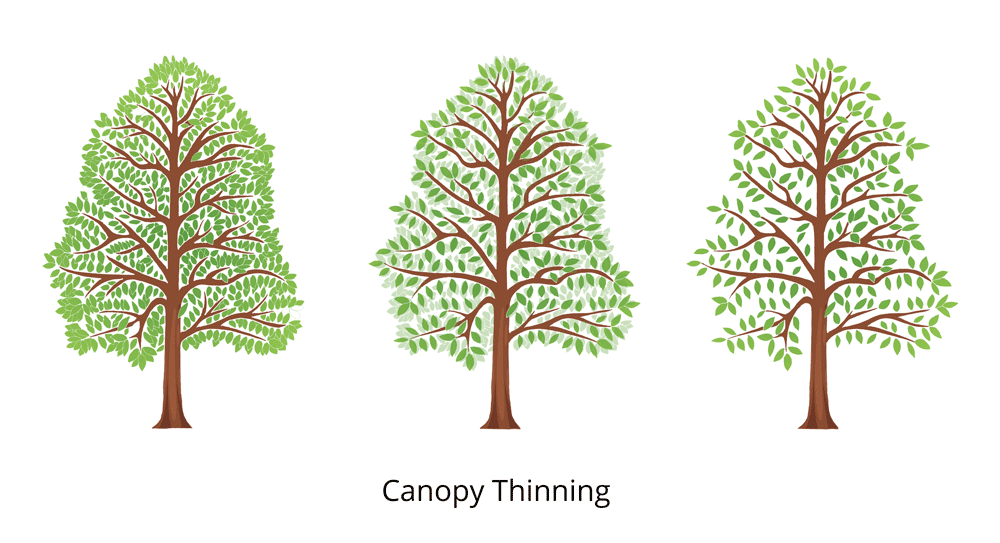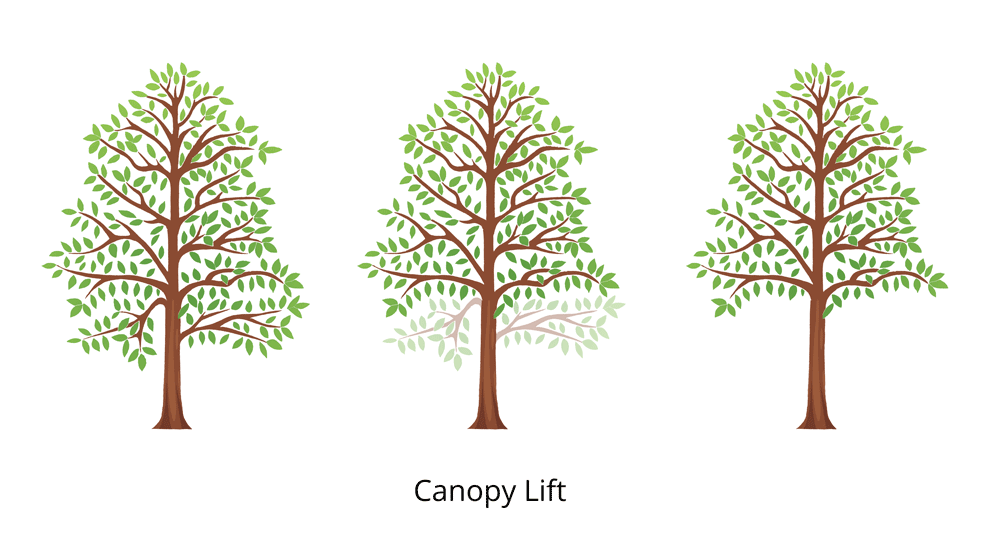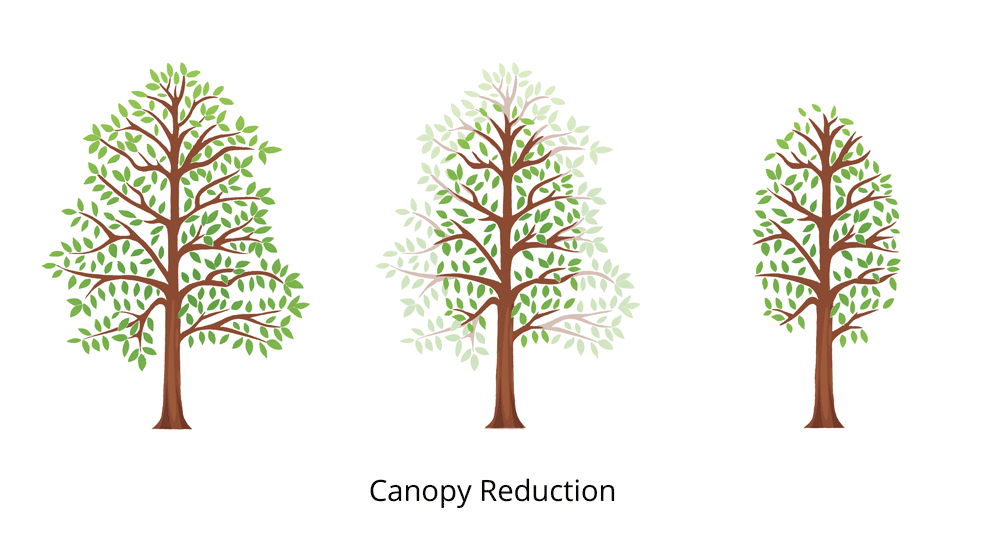The trimming of mature trees through crown cleaning is an extremely vital pruning exercise. This is because it can save declining trees from further deterioration while also helping healthy trees to better mature.
Crown trimming or cleaning consists of various techniques which has a host of benefits
| Technique/ Task | Benefit |
|---|---|
| Dead wood removal | Improves safety and boosts tree health |
| Removal of crossing branches | Reduces mechanical damage during windy days |
| Thinning | Better light penetration and air circulation reducing fungal issues |
| Canopy lift | Allows more light to penetrate home or lawn |
| Canopy reduction | Boosts overall health and enhances stability |
| Weight reduction | Improves safety and overall tree health |
What we cover
ToggleDeadwood removal
This is the selective removal of dead branches throughout the canopy. Dead branches1 are always in danger of falling anytime and can cause damage or injury. For the tree, they allow water and insects to enter the heartwood of the tree, which is detrimental to its health and causes further structural instability.
Removal of crossing branches
Removing branches that are either growing inwards toward the center of the canopy or where two branches are touching should be removed. When the wind is blowing, these branches can rub up against each other, shearing off protective bark and allowing water and insects to enter the tree.
Thinning
Crown thinning is the practice of selectively removing some second and third-order branches to allow more light penetration and airflow. This reduces the likelihood of fungal infections.
Removing 10-20% of the tree’s foliage also reduces the strain on the tree and will help promote new growth and the healing of old wounds.

Canopy lift
This is the removal of the lower branches of a canopy to help with building and pedestrian clearance. It also allows more light to penetrate your home or lawn.

Canopy reduction
The practice of crown reduction is the removal of the canopy’s outermost extremities to reduce the tree’s size. This promotes a healthier tree, much like crown thinning.

Weight reduction
This technique is mainly used when a tree is either leaning or the tree has too much foliage on one side or branch. This is done to promote structural stability to the roots of the tree by freeing up some weight and strain as well as promoting new growth in other areas of the tree.
Definition of tree crown cleaning?
Crown cleaning is the process of selectively trimming off vulnerable branches from the extension of a tree that proceeds upwards and outwards from the trunk. This extension is otherwise referred to as the crown.
The removal of such branches is usually done with a view of reducing the dangers that they may cause both to the tree and the objects in its surroundings.
Injury to humans as well as destruction of property are also some of the risks associated with the natural falling of such branches. The extent of injury and destruction is however also dependent on the weight and height position of such branches.
What does tree crown cleaning involve?
Crown cleaning which is also known as dead wooding generally involves the removal of problematic branches from a tree’s crown. It is normally done with a view of ensuring that the healthy vegetation on a tree continues thriving.
Mature trees are usually the best candidates for crown cleaning since they are very likely to develop declining vegetation as a result of age. They are also often vulnerable to death, crowding, crossing, weakening, and breaking of branches.
The objectives of tree crown cleaning
The primary objective of crown cleaning is to reduce the dangers that may occur if the diseased, dying, dead, and broken limbs of a tree are allowed to naturally shed off. Such risks include inhibition of tree growth, destruction of property, and human injury.
There are however other objectives that are usually based on aesthetic appearance. They include creating an even distribution of visual weight as well as ensuring the achievement of a more regular tree shape. Both of these go a long way in enhancing the tree’s visual appeal.
Crown cleaning is also done to enhance stability and openness in the structure of a tree. This is because such stability and openness often facilitate proper light penetration throughout the tree while also reducing any damage as a result of wind damage.
How often should you do tree crown cleaning?
It is usually advisable to crown a tree once or twice every five years. The frequency of crowning can however increase depending on the extent of stress and decline that a tree is undergoing. Trees undergoing extreme levels of deterioration often require expert crowning once every half year.
You can get three estimates from local tree service professionals in a matter of two minutes. Kindly follow the steps below to enjoy this great service:
- Scroll to the top of the page and enter your zip code
- Answer questions about your tree service job
- Your tree service details are forwarded to three local experts who will send you a price estimate for your job with some friendly advice
Tree crown cleaning cost
The average cost of crowning a tree is $950. This is however dependent on a wide range of factors which include tree size, species, location, reachability, and job difficulty. Based on these considerations, the crowning of a tree can either be as cheap as $100 or as costly as $1800.
One can however reduce the cost by opting to do the crowning himself as opposed to hiring professionals. In such cases, one should balance the monetary expense being saved versus the extent of risk being posed.
| Tree Height | Average Crowning Cost |
|---|---|
| 1-30 feet | $950 |
| 30-60 feet | $1,390 |
| 60 feet and above | $2,000 + |
Tools needed for DIY tree crown cleaning
The tools needed for crowning a tree include hand-held pruners, loppers, safety equipment, and ladders just to name a few. Since it can cost a fortune to acquire all these tools at a go, engaging tree crowning experts who already possess them is usually recommended.
| Tool | Average cost |
|---|---|
| Hand-held pruners and loppers | $40 |
| Gas pole pruner | $225 |
| Safety equipment | $100 |
| Ladder | $375 |
- University of Minnesota Extension, (2022) Pruning trees and shrubs. <https://extension.umn.edu/planting-and-growing-guides/pruning-trees-and-shrubs#dead-wood-removal-930281> Accessed: 16-03-2024














